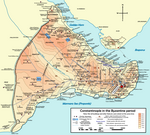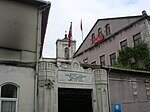Hekimoğlu Ali Pasha Mosque
18th-century mosquesFatihOttoman mosques in IstanbulTurkish mosque stubs

Hekimoğlu Ali Pasha Mosque is a mosque in the Fatih district of Istanbul, Turkey. It was commissioned by Hekimoğlu Ali Pasha, who was born in Istanbul in 1689, and completed in 1734–1735. It is considered as the last work of classical Ottoman architecture together with its külliye (charitable religious complex). The architects of mosque are Çuhadar Ömer Ağa and Hacı Mustafa Ağa.
Excerpt from the Wikipedia article Hekimoğlu Ali Pasha Mosque (License: CC BY-SA 3.0, Authors, Images).Hekimoğlu Ali Pasha Mosque
Alipaşa Cami Avlusu Sokağı, Istanbul
Geographical coordinates (GPS) Address External links Nearby Places Show on map
Geographical coordinates (GPS)
| Latitude | Longitude |
|---|---|
| N 41.006158333333 ° | E 28.934972222222 ° |
Address
Hekimoğlu Alipaşa Camii
Alipaşa Cami Avlusu Sokağı
34098 Istanbul
Türkiye
Open on Google Maps








